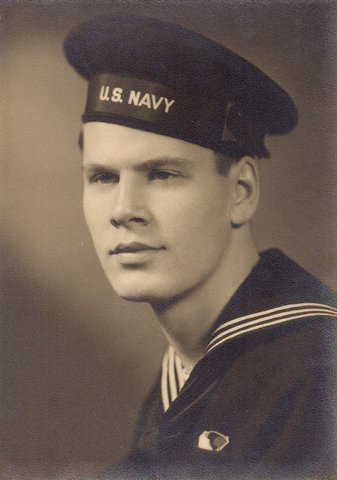
(Photo (c. 1941) of my Uncle Bob, U.S. Navy Air Corps.)
My Uncle Bob Lawton was born and grew up on Sluice Pond, which is part of the Wyoma section of, Lynn, Massachusetts, “Where,” he would always quip, “I could swim, skate, sled, and ski in my backyard.”
Uncle Bob was an inveterate storyteller. He often told me what life was like when he was a boy. For instance:
“The whole neighborhood gang, including girls, looked forward to an enchanted hour between the end of daylight, which ended our outdoor activities, and supper time. We would troop indoors, shedding our soggy outer clothing and switch on the radio. Our radio was a table model Philco that cost us $25.00 and it took us a year to pay for it in those early days of the Installment Plan.
In the mid–1930’s the popular programs were Buck Rogers in the 25th Century, Bobby Benson and His H–O Ranchers, Jack Armstrong, the All American Boy, who attended Hudson High ( I can still sing the “Hudson High Fight Song!”), Dick Tracey, and Tom Mix and His Straight Shooters.”
From the moment I can first recall him being in my life, he was always telling me stories. These stories were ones I never tired of hearing; and, he was such an animated and great storyteller I never minded when they were repeated. As a matter of fact, I was always looking forward to having him tell them to me.
He also talked with me about the Great Depression, a
“time when this great country knew what a real Depression was; a time when, out of a total population of 130 million people, there were 12 million unemployed.
I mean unemployed, able–bodied men, not women or some men delivering laundry, potato chips or bread for a wage of $12.00 per week, or Sharecroppers working for subsistence and $50.00 cash per year. A time when bakers each baked 1,000 loaves for every $1.00 in their pay checks. It was a grim time for adults and, in particular, for parents.”
I think Uncle Bob always enjoyed telling the stories he told even more than his audience. He would laugh at what he would say and take incredible self–enjoyment hearing himself talk about the friends and adventures he knew and experienced when he was younger. He could take almost any popular joke and turn it into a story of varying lengths, depending upon the patience of his audience in attending to his tale.
My uncle’s ability to tell a story was an absolute delight to me. Listening to him talk about life, the universe and everything in between was never tiring for me. It was sheer magic. He was the first adult in my life who actually talked with me, not at or to me. While my
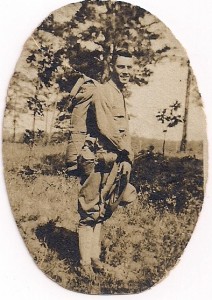
Uncle Bob’s Father: Frederick “Henry” Lawton (1891-1966), U. S. Army (c. 1917).
father’s side gave me an incredible look into the Azorean culture, my uncle gave me the complementary perspective and chronicles about what it was like growing up in a generations old American family.
Besides his love for my aunt and his family, he had four great passions, these being the outdoors, sports (especially golfing and skiing), music (classical and opera) and working around the house—he called it tinkering. He could repair and build just about anything that he put his mind to doing so.
One day, when I was six, he brought a bag of his golf clubs into his car to go ”work on his swing.” This golf set contained some of the woods and irons that he had played with since he was a young man. Even then, many of these clubs were considered antiques; yet, each one had an unforgettable story attached to it. Seeing me watching him, he invited me to go with him.
It was a beautiful, Rehoboth spring day in 1954. It was a weekend. He went to one of the elementary schools in town, where once he parked the car and stepped out the driver’s side, he hoisted the bag onto his shoulders from the back seat and walked out onto the nearby, empty field. I tagged along with him. He proceeded to talk about his love of the game and how he would swing the golf clubs in the manner of Ben Hogan.
I did not know it at the time, but Uncle Bob was a PGA certified gold instructor. That fact would not have mattered anyway because the moment I saw him address the ball with a wooden handled driver and hit it out of my sight, I was completely enchanted by “the game”. To this day, and except for some professional players, I have never seen anyone hit a ball off the tee like my uncle could do. Upon contact with the head of the club, the ball would skim over the ground, gradually attaining a greater and greater height until it soared into the sky and disappeared. Unbelievable.
As a result of seeing this feat of physical mastery, I had to learn how to do the same thing. Thus, when we arrived back at the new home he was building next door to his old house, I pestered him to teach me how to swing a club like he did.
We went to the back of the house. There were building materials all over the place. Pine boards for the flooring, two by fours for the frames being built, a cement mixer waiting to be loaded with the bags of cement around it, and assorted tools, drills, saws, hammers and shingles were all assembled in mixed array waiting for my uncle to summon them to work.
Yet, he did not turn to his work on the house. Instead, he kept looking around on the ground in the surrounding area. I kept waiting for him to get his golf bag and give me a club so I could swing the thing around. Being tremendously eager to learn, I was getting exasperated because he seemed to forget I was there, even though he kept a running story going about how he learned to play golf.
Finally, when I couldn’t stand it any longer, he bent down and picked up what looked like a six foot, inch–and–a–half diameter piece of rubber tubing.
I was totally perplexed. What’s this got to do with learning to play golf?
Walking over to me with the tubing in his right hand, he explained to me that he was going to teach me how to swing the tubing as if it were a golf club in my own hands.
Now I was totally mystified. I could not make the connection between trying to swing a piece of tubing and learning to swing a wood or an iron.
He had me stand in front of him away from the reach of the tubing while he demonstrated what he wanted me to do.
With his work boots on, Uncle Bob stood at six feet, three inches in height. That was fairly gigantic to a mere boy. I saw him swing the tubing as if it were the easiest thing in the world to do. He did it with such ease, grace and joy that I, too, wanted to do it in the same way he was demonstrating to me. I didn’t care that it was a piece of tubing. My uncle would show me how to do it.
“If you can learn how to swing this tubing effortlessly the way I will show you,” he explained to me, “I promise you that you will be able to use any of the clubs in this bag with greater ease than most folks do on the golf course.”
Once he showed me how to grip the tubing with my left and right hands interlocked the way one would hold a golf club, I spent the rest of that day, and many days thereafter, swinging that tubing until I could move it through the air as easily as a six–year–old child could attempt to do so.
My uncle never yelled at me. He never made fun of what I could not do correctly. He was the most patient man I have ever known. Besides all of that, I learned more about who Ben Hogan was and the impact he had on the game of golf and his theory of learning how to play the game itself.
Uncle Bob made learning a complicated, almost impossible task to accomplish an easy thing to do. All the while I was learning how to swing a six foot piece of tubing, he had me laughing and enjoying the stories he told about his life and the people he knew.
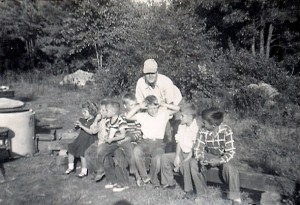
Uncle Bob with the Younger Generation (c. 1952).
He helped teach me how to ski. He could take a group of young people and have them ignore immediately taking a ski lift, climbing to the top of a mountain, instead, with their skis on their backs.
“It’s the best way to appreciate where you’re at,” he would tell us.
Once, on top of the mountain and at the head of a trail, we skied down it with great abandon. When we next used the ski lift for the first time that day, we did so with much appreciation for having it transport us uphill with such ease.
His love for the outdoors was so infectious that I still have the same joy now as I did when walking through the natural world with him then at that time in my youth.
He helped inspire my love of classical music. The first three LP (long playing) records I had consisted of the Grand Canyon Suite, by Ferd Grofé (1929–1931), the 1812 Overture, by Pyoty Ilyich Tchaikovsky (1880), and Victory at Sea, by Richard Rogers (1952). I would not go to sleep when I was a child until I could listen to them before I went to bed.
I memorized my first story from his Marshall Dodge collection of Downeast humor.
Uncle Bob Lawton: (1994) Rehoboth Memorial Day Parade
My uncle, Robert S. Lawton, was born on 15 November 1921. He served our nation from September 29, 1942 until March 3, 1946. He was in the Navy Air Corps where he was based at the Naval Station Argentia, which was in the former Dominion of Newfoundland. During the war, it “was used to base convoy protection, coastal patrol and anti-submarine aircraft, both land-based aircraft and seaplanes.”
On 3 September 1946, and after serving in the Navy, he married my Aunt Ellie (1925– ), who is pictured to my mother’s left in the January 14, 2016 post of this weblog site. Aunt Ellie and Uncle Bob had one daughter, who is my beloved cousin Cathy.
For 35 years, before retiring in 1983, he was a Piping Engineer for ITT Grinnell.
Uncle Bob played with the Seniors Hockey League at the Dennis M. Lynch Arena in Pawtucket, Rhode Island. I recall, perhaps incorrectly, that the players skated for two minutes on the ice and rested for five
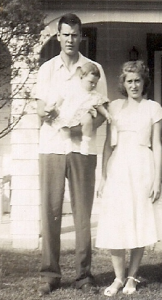
Uncle Bob, Aunt Ellie & Cathy (c. 1950).
During one game in particular (February 1, 1995), Uncle Bob scored a goal while it was his time on the ice. He returned to the bench, sat down, placed his hockey stick between his legs and appeared to be resting. His fellow teammates on the bench alongside him continued talking with one another. On occasion they would tease him. They became concerned when “Lawton” wasn’t responding to their jests.
Much to their great chagrin and loss, they discovered that Uncle Bob had unexpectedly passed away.
I cannot think of a better way of dying. Yet, that was my uncle: his final moments on the ice summed up the quality of his life and the grace with which he seemed to pass through it. I know that he will always be one of my truest and greatest of heroes.
In part, I dedicated my doctoral dissertation on critical thinking and creativity to him. If I had never known him, I would not be who I am today, and I would be a far poorer person for it as a result. I think this dedication that I wrote fairly summarizes my feelings about him:
“With appreciation and love to my uncle, Robert Lawton, who treasures imagination, wonder, humor and play with patience and love” . . .
Related Links:
https://en.wikipedia.org/wiki/Ben_Hogan
https://search.yahoo.com/yhs/search?p=Ben+Hogan&ei=UTF-8&hspart=mozilla&hsimp=yhs-002
https://www.youtube.com/watch?v=N1l5vgY_3tw
Notes:
The first two highlighted quotes in purple above are excerpts from an unpublished story entitled, “You Never Know,” that Uncle Bob wrote in the early 1990’s. They are representative of the stories he would recount to me about his own boyhood.
Works Cited:
Carreiro, A. Keith, Ed.D. (1992). A philosophical inquiry into critico–creative teaching: Toward an informed pedagogy. (Doctoral dissertation). Retrieved from ProQuest Dissertations and Theses. (Accession Order No. AAT 9219106.)
If you enjoyed reading this post, please share it with others.
Disclosure of Material Connection: I have not received any compensation for writing this post. I have no material connection to the brands, products or services that I have mentioned here. I am disclosing this information in accordance with the Federal Trade Commission’s 16 CFR, Part 255: “Guides Concerning the Use of Endorsements and Testimonials in Advertising.”
© 10 February 2016 by A. Keith Carreiro


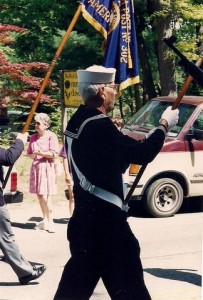
2 comments. Leave new
What a wonderful tribute to your Uncle Bob!
Thank you, Carolyn. I hope it is a fitting tribute not just to him, but to all of those men and women who were in my family, as well as to those of the “Greatest Generation,” who helped raise all of us young ones.